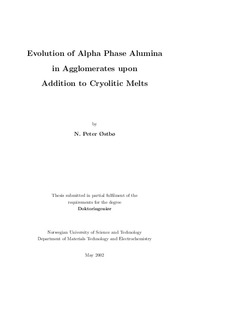| dc.contributor.author | Østbø, Niels Peter | nb_NO |
| dc.date.accessioned | 2014-12-19T13:10:39Z | |
| dc.date.available | 2014-12-19T13:10:39Z | |
| dc.date.created | 2002-05-24 | nb_NO |
| dc.date.issued | 2002 | nb_NO |
| dc.identifier | 121816 | nb_NO |
| dc.identifier.isbn | 82-471-5445-5 | nb_NO |
| dc.identifier.uri | http://hdl.handle.net/11250/244446 | |
| dc.description.abstract | Rapid dissolution of alumina upon addition to the cryolitic melt is crucial for the modern Hall-Heroult process for aluminium production. The formation of slow - dissolving alumina agglomerates may be detrimental, and irregular dissolution kinetics may cause the loss of process control. So-called anode effects may subsequently ignite, which are a major source of green-house gases from the primary aluminium industry.
A literature review and the study of the theory of sintering provides the background for discussing the present work. The most probable mass transport mechanism in the transition alumina-fluoride-moisture system studied here is surface diffusion. Surface diffusion is a non-densifying mass transport mechanism that will result in coarsening (alumina grain growth) but only weak interparticle bonding since no macroscopic shrinkage is involved. Rapid mass transport is known to result when there is a simultaneous phase transformation, and this is the case when transition alumina transforms to α-alumina, catalyzed by the presence of fluorides.
The main experimental techniques used in the present work were powder X-ray diffraction (XRD) and Scanning Electron Microscopy (SEM). Supporting techniques used have been speciffc area determination by the BET method and simple thermo-gravimetric techniques. An optical furnace was designed and built in order to study the dissolution of tablet alumina agglomerates.
A preliminary agglomeration study of preformed cylindrical alumina samples served to map some of the most important mechanisms involved when alumina powder interacts with alumina-saturated cryolitic melt. The conditions at the alumina-melt interface were studied, but it is concluded that the experimental method could not provide the necessary parameter control in order to study the agglomeration mechanism in further detail.
The tablet agglomerate study is the major experimental contribution of the present work. The experimental method provided good control of the sample chemistry and well defined temperature and time variables. It is concluded that liquid cryolitic melt (NaAlF4) provides an effective mass transport route for the transformation assisted growth of α-alumina platelets. The platelets that initially form will provide the limited mechanical strength necessary for agglomerate formation and their persistence in a cryolitic melt. Alumina agglomeration may therefore take place with only partial, initial phase transformation. It is concluded that differences in the agglomeration behavior of various qualities of alumina may be the rate determining property for alumina dissolution kinetics in cryolitic melts. Differences in the agglomeration behavior may be due to a number of physical properties of alumina. It is argued here that the fundamental, but difficult to measure, alumina nano-structure may be most important.
The alumina nano-structure is correlated to secondary alumina properties such as the α-alumina content, specific surface area (BET) and moisture content (MOI, LOI). In this study an X-ray diffraction line profile analysis using the Warren-Averbach method shows that there is a significant difference in the nano-structure of the two smelter grade alumina qualities under study. This may explain the different agglomeration behavior that is observed.
An optical study of tablet agglomerate dissolution in cryolitic melt proved to be largely unsuccessful due to severe corrosion of the quartz crucibles used. However, a proposed mechanism for the tendency for disintegration of alumina agglomerates, thus dissolving as \snow-flakes" is supported.
The temperature response time in the tablet alumina samples was studied in order to determine the experimental limit of the shortest time period possible in the experiments. The exothermal γ -> α transformation is observed for secondary alumina samples containing adsorbed fluorides. An interesting effect of the carbon content in secondary alumina is also shown.
The moisture content of smelter grade alumina is a function of the alumina quality, in particular the technology used for the calcination of the aluminium trihydrate precursor. In the current study the moisture content is shown to be a dynamic function of the ambient temperature and relative humidity. The moisture content is an important variable for the study of alumina agglomeration, and for the fluoride emission from the Hall-Heroult process. The kinetics of moisture desorption and absorption for various alumina qualities is studied. The desorption kinetics is concluded to be signifcantly different, while it is also shown that practical absorption kinetics is a function of the sample size and available surface area. | nb_NO |
| dc.language | eng | nb_NO |
| dc.publisher | Fakultet for naturvitenskap og teknologi | nb_NO |
| dc.relation.ispartofseries | Dr. ingeniøravhandling, 0809-103X; 2002:50 | nb_NO |
| dc.subject | | en_GB |
| dc.subject | Materialvetenskap | en_GB |
| dc.subject | TECHNOLOGY: Materials science | en_GB |
| dc.title | Evolution of Alpha Phase Alumina in Agglomerates upon Addition to Cryolitic Melts | nb_NO |
| dc.type | Doctoral thesis | nb_NO |
| dc.source.pagenumber | 252 | nb_NO |
| dc.contributor.department | Norges teknisk-naturvitenskapelige universitet, Fakultet for naturvitenskap og teknologi | nb_NO |
| dc.description.degree | dr.ing. | nb_NO |
| dc.description.degree | dr.ing. | en_GB |
